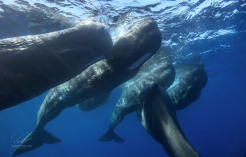Whales
Whales are an order of marine mammals divided into two main groups: baleen whales (Mysticeti) and toothed whales (Odontoceti). There are over 90 species of whales worldwide.
Species and Size
The size of whales varies greatly, from the small harbor porpoise at about 1.5 meters in length to the largest animal that has ever lived on Earth: the blue whale.
- Baleen Whales: These whales have no teeth, but instead use baleen plates to filter krill, small crustaceans, and fish from the water. This group includes the
largest whale species:
- Blue whale: At up to 33 meters long and weighing up to 200 tons, it's the largest animal in the world.
- Fin whale: The second-largest whale, it can reach up to 27 meters long and weigh 80 tons.
- Humpback whale: Known for its acrobatic leaps and songs, it reaches a length of 12 to 18 meters.
- Gray whale: A long-distance traveler that grows up to 15 meters long.
- Toothed Whales: As the name suggests, these whales have teeth. They include dolphins, porpoises, and orcas.
- Sperm whale: At 15 to 20 meters long, it's the largest toothed whale. It can dive to depths of 1,000 meters and more.
- Orca (Killer whale): The largest dolphin species, reaching a length of 6.5 to 8 meters and is an apex predator.
- Bottlenose dolphin: The most well-known dolphin, growing up to 4 meters long.
Source Pic: By Will Falcon aka Vitaly Sokol - own work, CC BY 4.0, https://commons.wikimedia.org/w/index.php?curid=89731919
Source Text Reference - https://en.wikipedia.org/wiki/Cetacea
Distribution
Whales live in all the world's oceans, from the polar waters of the Arctic and Antarctic to the warm waters of the tropics. Most species live in saltwater, but there are also some river dolphin species that are found in freshwater.
Lifespan
The lifespan of whales depends heavily on the species:
- The bowhead whale is the longest-living mammal in the world. Some individuals have lived for over 200 years.
- Fin whales can live for over 100 years.
- Blue whales have a lifespan of 80 to 90 years.
- Sperm whales can live to be 50 to 100 years old.
- Smaller species like the bottlenose dolphin can live for over 40 years, while harbor porpoises often only live for 8 to 10 years.
Predators
Due to their size, most adult whale species have few natural predators.
- Orcas are known predators that occasionally attack larger whales, especially young or weakened individuals.
- Sharks also pose a threat, particularly to smaller whale species and juveniles.
- Humans are the biggest threat to whales. Due to whaling, marine pollution, ship traffic, underwater noise, and bycatch in fishing nets, many whale populations are highly endangered.
Source Pic: Bernard Spragg. NZ from Christchurch, New Zealand, CC0, via Wikimedia Commons, https://commons.wikimedia.org/wiki/File:Whale_fluke._(9112595870).jpg
Source Text Reference - https://en.wikipedia.org/wiki/Cetacea


